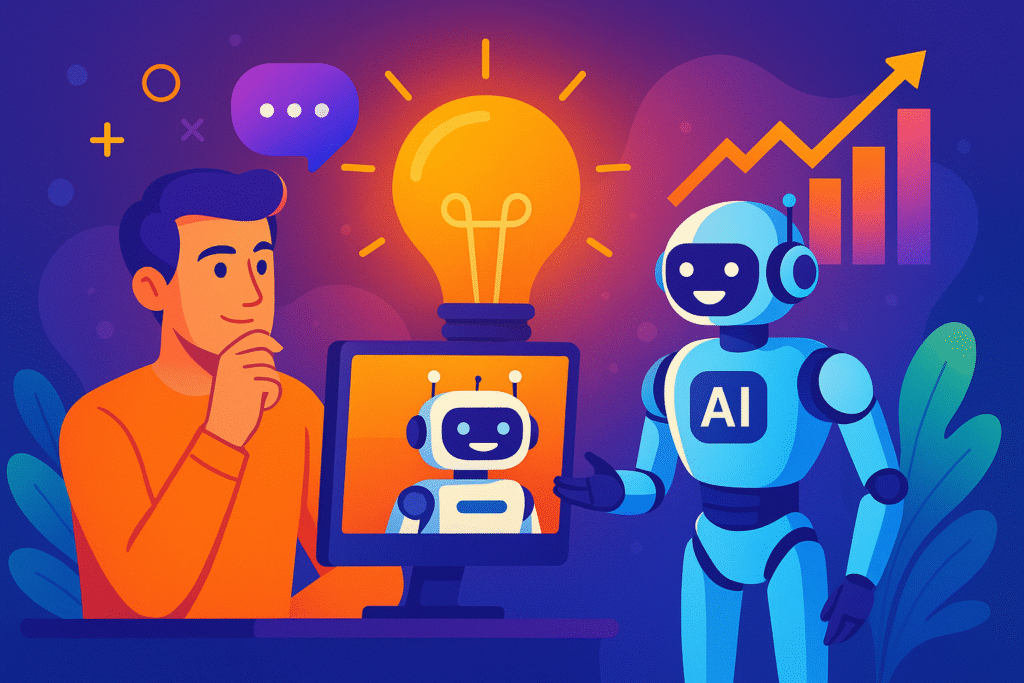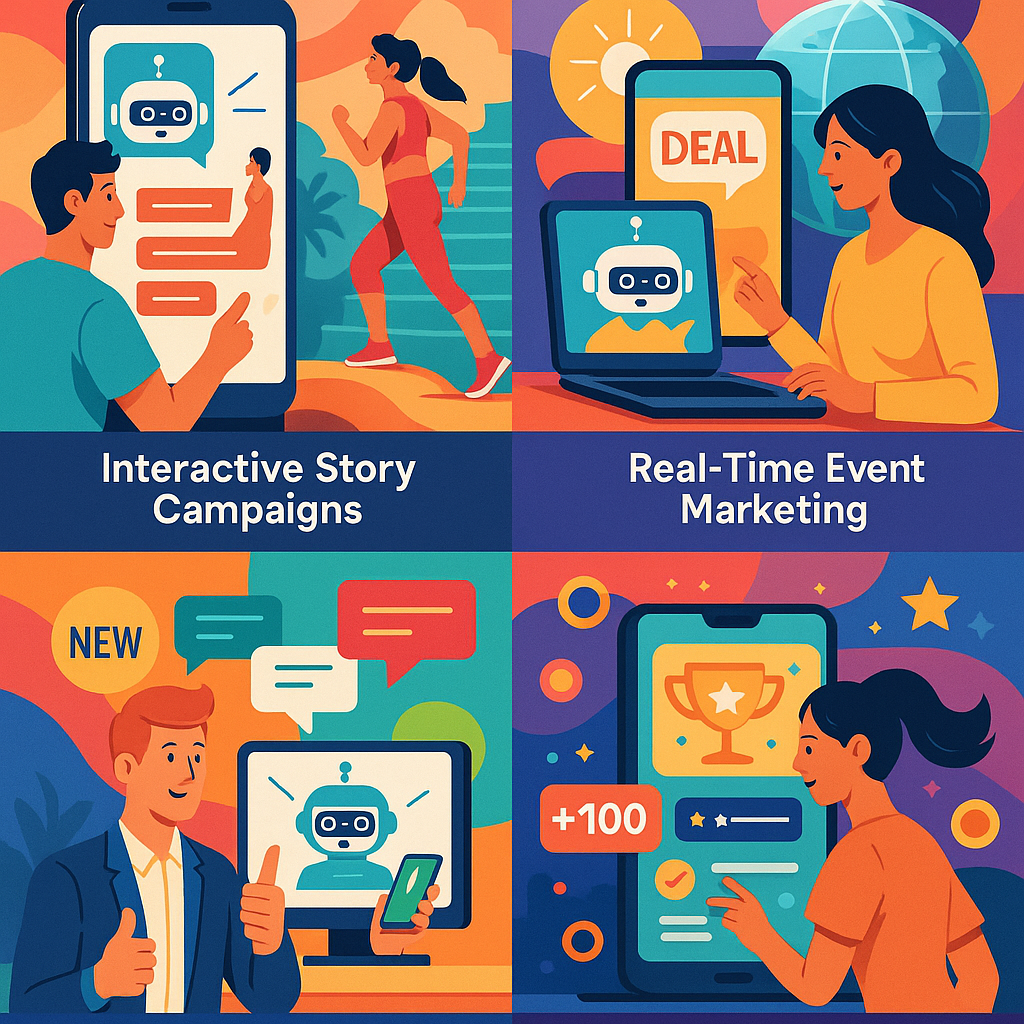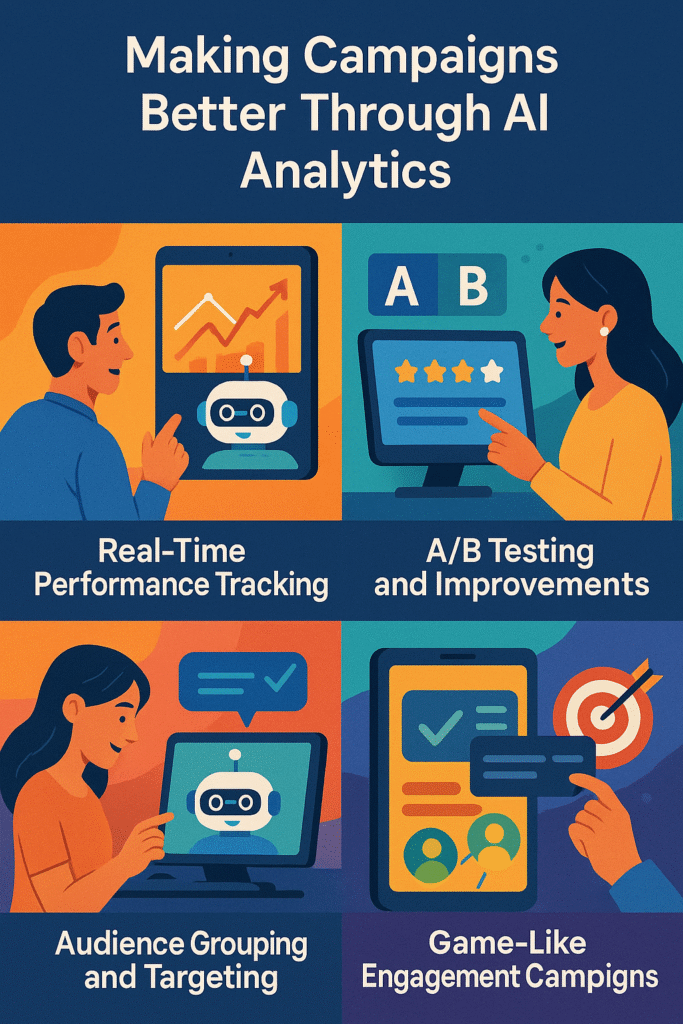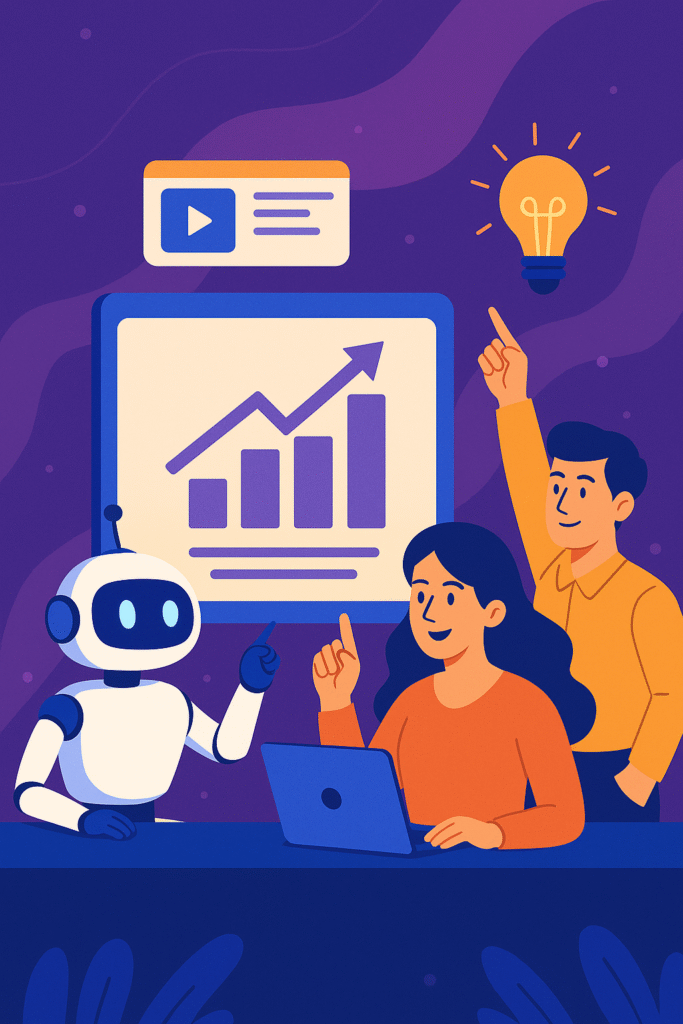Table of Contents
Campaign ideas with AI is changing how marketing teams create new ideas and plan their strategies. Many marketers struggle to come up with fresh campaign concepts that grab attention in today’s busy online world. Regular idea creation meetings often run out of steam, limited by time and human thinking patterns.
Using artificial intelligence in marketing work has created new chances for better campaign ideas. Chatbots now work as helpful creative partners, giving fresh views and data-based insights that boost human creativity. This team approach changes how groups create, improve, and run marketing campaigns across different platforms.
The combination of human creativity and AI intelligence creates powerful results. Marketing professionals can now access vast amounts of data and generate multiple creative directions in minutes rather than hours. This efficiency allows teams to focus on strategy and execution while AI handles the heavy lifting of idea generation.

How Chatbots Started Supporting Campaign Strategies
Marketing teams around the world are finding out how AI helps with campaign planning. The technology has grown from basic automated replies to smart creative helpers that understand context, brand voice, and audience needs.
Recent research shows that companies using AI for campaign work report 40% faster idea creation and 25% better engagement rates. A study by McKinsey highlights how well human-AI teamwork works in creative projects.
The move toward AI-powered marketing means more than just new technology. It shows a basic change in how creative workers solve problems and create new ideas. Chatbots bring special benefits to idea creation, including huge knowledge bases, pattern spotting skills, and the ability to handle many creative paths at once.
Early adopters of AI in marketing have discovered significant advantages over traditional methods. They can test more concepts, reach wider audiences, and adapt campaigns quickly based on real-time feedback. This flexibility has become crucial in today’s fast-moving digital environment.
The technology has also made campaign development more accessible to smaller teams. Previously, large-scale creative projects required extensive resources and personnel. Now, a small marketing team can leverage AI to compete with larger organizations by generating professional-quality campaign ideas. Tools like ChatGPT and Claude have democratized access to advanced AI capabilities for businesses of all sizes.
What Chatbots Bring to Campaign Planning
Modern chatbots have advanced language skills that allow detailed talks about campaign strategies. These systems can study market trends, competitor actions, and consumer behavior patterns to suggest useful creative directions.
The technology is great at linking different concepts to create fresh campaign angles. A chatbot might suggest connecting a coffee brand with green practices, work productivity, or community building based on current market trends and consumer interests.
Advanced AI systems can remember context during long idea creation sessions. They recall previous suggestions, build on earlier concepts, and change their recommendations based on feedback. This consistency creates better developed campaign strategies.
Chatbots excel at processing multiple data sources simultaneously. They can analyze social media sentiment, review industry reports, track competitor activities, and monitor consumer discussions to inform campaign recommendations. This comprehensive analysis would take human teams weeks to complete.
The speed at which chatbots operate allows for rapid iteration and refinement of campaign concepts. Marketing teams can explore dozens of different approaches in a single session, testing various angles and messaging strategies until they find the most promising direction.
Smart Ways to Use Chatbots for Campaign Strategies
Set Clear Goals for Campaign Planning
Good collaboration starts with clear campaign objectives and target audience details. Chatbots work best when given detailed briefs that include brand positioning, competitor landscape, and wanted outcomes.
The process begins with giving the AI complete background information about the brand, product, or service. This includes brand values, past campaign results, and current market challenges. The more context provided, the more relevant and focused the suggestions become.
Successful AI collaboration requires specific parameters and constraints. Teams should define budget ranges, timeline requirements, and channel preferences before starting the creative process. This framework helps the AI generate realistic and actionable campaign ideas.
Use Chatbots for Audience Research and Insights
Campaign development benefits a lot from AI’s ability to analyze huge amounts of consumer data and spot new trends. Chatbots can process social media talks, review sentiment analysis, and highlight relevant cultural moments that might inspire campaign themes.
The technology is excellent at finding small trends that human researchers might miss. These insights often lead to new campaign angles that connect with specific audience groups. For example, a chatbot might spot growing interest in sustainable packaging among millennials, inspiring an eco-friendly campaign approach. Platforms like Google Trends combined with AI analysis can reveal emerging consumer interests before they become mainstream.
AI can segment audiences in ways that humans might overlook. The technology identifies behavioral patterns, purchasing habits, and engagement preferences that inform more targeted campaign strategies. This precision targeting often results in higher conversion rates and better return on investment.
Generate Multiple Campaign Ideas with Chatbots
One of AI’s best strengths is its ability to explore many creative paths at the same time. While human idea creation usually follows straight thought processes, chatbots can create dozens of campaign concepts within minutes.
This ability lets marketing teams explore creative areas they might not have thought of before. The AI can suggest campaigns based on emotional triggers, seasonal trends, cultural events, or new technologies, giving a full range of options for review.
The parallel processing capability of AI means teams can evaluate multiple campaign directions simultaneously. This approach reduces the risk of committing to a single creative direction that might not resonate with the target audience.
Real Examples of Chatbots in Campaign Strategies

Interactive Storytelling with Chatbots
Today’s consumers want real brand stories that match their values and experiences. AI-powered campaigns can create interactive stories that change based on user choices and preferences.
A fitness brand might develop a campaign where users follow different workout paths through chatbot interactions. Each path shows personalized content, product recommendations, and motivational messages tailored to individual fitness goals and preferences.
These campaigns create deeper engagement by allowing consumers to actively participate in the brand narrative. The AI tracks user choices and adapts the story accordingly, creating a unique experience for each participant.
Interactive storytelling campaigns often generate higher social media sharing rates because users feel more connected to the content. The personalized nature of these experiences encourages word-of-mouth marketing and organic brand advocacy.
Real-Time Engagement Campaign Strategies
Chatbots excel at creating campaigns that respond to current events and trending topics. This ability helps brands stay relevant and engage audiences during important cultural moments.
A food delivery service could use AI-powered campaigns that adjust messaging based on weather conditions, local events, or trending social media topics. The system automatically creates relevant content and promotional offers that match current situations.
Real-time marketing requires quick decision-making and rapid content creation. AI enables brands to capitalize on trending moments before they lose relevance, giving them a competitive advantage in fast-moving markets. Hootsuite’s social listening tools combined with AI can help brands identify and respond to relevant trends instantly.
The technology can monitor multiple trending topics simultaneously and determine which ones align with brand values and target audience interests. This filtering capability ensures that real-time campaigns remain authentic and appropriate. Real-time event campaigns often leverage social media features such as Instagram Reels vs Stories to match audience preferences.
Personalized Product Launch Campaigns
AI-driven campaigns can create unique experiences for different audience groups during product launches. The technology analyzes customer data to find the most effective messaging, timing, and channels for each demographic group.
Technology companies often use this approach to launch new products with different messaging for business customers versus individual consumers. The AI creates tailored content that speaks to specific problems and use cases for each segment.
Personal campaigns increase the likelihood of purchase by addressing individual customer needs and preferences. The AI can customize everything from product demonstrations to pricing strategies based on customer segments.
This approach often results in higher conversion rates and better customer satisfaction because the messaging feels more relevant and targeted to each audience group.
Game-Like Engagement Campaign strategies with chatbots
Interactive campaigns that use gaming elements often get higher engagement rates. AI can design complex gamification strategies that adapt to user behavior and preferences over time.
Retail brands often use point-based systems where customers earn rewards through various interactions. The AI watches engagement patterns and adjusts game mechanics to keep interest and encourage continued participation.
Gamified campaigns tap into natural human desires for achievement and competition. The AI can create challenges that are difficult enough to be engaging but achievable enough to maintain motivation.
These campaigns often generate valuable customer data because participants willingly share information in exchange for rewards and recognition. The AI uses this data to further personalize the gaming experience.
Improving Campaign Performance with Chatbots

Real-Time Tracking and Campaign Optimization
AI systems provide continuous campaign performance analysis that enables quick improvements. These tools track engagement metrics, conversion rates, and audience sentiment in real-time, allowing for immediate adjustments.
The technology spots patterns that might show declining performance before big drops happen. This predictive ability enables proactive campaign changes that maintain effectiveness throughout the campaign lifecycle.
Real-time analytics help marketing teams identify which campaign elements are working and which need adjustment. This immediate feedback loop allows for continuous optimization without waiting for campaign completion.
The ability to make mid-campaign adjustments often means the difference between a successful campaign and a failed one. AI-powered analytics provide the insights needed to make these critical decisions quickly. Tools like Google Analytics integrated with AI can automatically flag performance anomalies and suggest corrective actions.
Data-Driven Testing and Planning
Chatbots can handle multiple campaign variations at once and analyze their performance across different audience segments. This ability enables complete A/B testing that would be impossible to manage manually.
The AI continuously improves campaign elements based on performance data. It might adjust messaging tone, visual elements, or distribution timing to improve results without requiring human help.
Advanced A/B testing through AI can test hundreds of variations simultaneously, providing statistically significant results much faster than traditional methods. This speed allows for rapid optimization and improved campaign performance.
The technology can identify subtle performance differences that humans might miss, leading to more refined and effective campaign strategies over time.
Audience Segmentation and Campaign Targeting
Advanced AI systems excel at finding subtle audience segments that respond differently to campaign messaging. These insights enable more precise targeting and personalized content delivery.
The technology analyzes behavioral patterns, engagement history, and demographic data to create detailed audience profiles. These profiles inform campaign customization that improves relevance and effectiveness.
AI can identify micro-segments within broader audience groups, allowing for highly targeted messaging that resonates with specific customer needs and preferences. This precision targeting often results in better campaign performance.
The continuous learning capability of AI means that audience segments become more refined over time, leading to increasingly effective targeting strategies.
Solving Common Challenges in Chatbot Campaign Strategies
Maintaining Brand Consistency in Campaigns
While AI creates many creative options, keeping brand consistency requires careful oversight. Successful campaigns balance AI-generated creativity with established brand guidelines and values.
Marketing teams must establish clear rules for AI-generated content that align with brand personality and messaging standards. This ensures that creative output remains authentic and recognizable to existing customers.
Brand authenticity becomes more challenging when using AI because the technology might suggest ideas that technically work but don’t feel authentic to the brand. Human oversight is essential to maintain brand integrity.
Regular brand audits of AI-generated content help ensure consistency across all campaign materials. Teams should develop checklists and approval processes that verify brand alignment before launching campaigns.
Balancing Automation and Human Creativity in Planning
The most effective campaigns combine AI efficiency with human insight and emotional intelligence. Technology handles data processing and pattern recognition while humans provide strategic direction and creative judgment.
Teams that successfully integrate AI into their workflow maintain clear roles for both human and artificial intelligence contributions. This collaboration maximizes the strengths of both approaches while minimizing their respective limitations.
Human creativity remains essential for understanding emotional nuance, cultural context, and strategic vision that AI cannot fully grasp. The best campaigns use AI to enhance rather than replace human creative capabilities.
Finding the right balance requires experimentation and adjustment over time. Teams must learn when to trust AI recommendations and when to override them based on human judgment and experience.
Managing Data Privacy and Compliance
AI-powered campaigns must follow data protection rules while delivering personalized experiences. This requires careful consideration of data collection, storage, and usage practices.
Marketing teams need complete understanding of privacy regulations in their target markets. AI systems should incorporate privacy-by-design principles that protect consumer data while enabling effective campaign personalization. Resources like GDPR.eu provide essential guidance for compliance in European markets.
Compliance challenges become more complex when using AI because the technology can process and combine data in ways that might raise privacy concerns. Teams must establish clear data governance policies.
Regular compliance audits and legal reviews help ensure that AI-powered campaigns meet all regulatory requirements while maintaining effectiveness and personalization capabilities.
Future Trends in AI-Powered Campaign Development
Better Natural Language Processing
Emerging AI technologies will enable more sophisticated conversation capabilities between marketers and chatbots. These improvements will facilitate more nuanced creative discussions and complex strategic planning.
Future systems will better understand context, emotion, and creative intent, leading to more relevant and innovative campaign suggestions. This evolution will blur the line between human and artificial creative contributions.
Natural language processing improvements will make AI collaboration feel more natural and intuitive. Marketers will be able to communicate with AI systems using everyday language rather than technical commands. Companies like OpenAI continue to advance these capabilities, making AI more accessible to marketing professionals.
These advances will enable more complex creative discussions where AI can understand abstract concepts, metaphors, and cultural references that inform campaign development.
Predictive Campaign Modeling
Next-generation AI will predict campaign performance with greater accuracy, enabling better resource allocation and strategic planning. These capabilities will reduce campaign risks and improve return on investment.
The technology will analyze historical performance data, market conditions, and consumer behavior patterns to forecast campaign outcomes before launch. This predictive capability will change campaign planning and budgeting processes.
Predictive modeling will help marketing teams choose between different campaign concepts based on likely performance outcomes. This data-driven approach will reduce guesswork and improve campaign success rates.
The ability to predict performance will also enable more accurate budget allocation and resource planning, leading to more efficient marketing operations. Marketers exploring new methods can also refer to a guide to AI-powered ad campaigns for additional strategic approaches
Cross-Channel Integration
Future AI systems will easily coordinate campaigns across multiple channels and platforms. This integration will ensure consistent messaging and optimal resource distribution throughout the customer journey.
The technology will automatically adjust campaign elements based on channel-specific requirements while maintaining overall strategic coherence. This capability will simplify complex multi-channel campaign management.
Cross-channel integration will enable more sophisticated customer journey mapping and personalization strategies. AI will track customer interactions across all touchpoints and optimize messaging accordingly. Platforms like HubSpot are already integrating AI to provide seamless cross-channel campaign management.
This integration will also provide better attribution and performance measurement across all marketing channels, leading to more accurate ROI calculations and strategic insights.
Measuring Success in AI-Assisted Campaigns
Key Performance Indicators
Successful AI-powered campaigns require complete measurement frameworks that track both traditional metrics and AI-specific performance indicators. These measurements should include creativity scores, idea generation speed, and collaboration effectiveness.
Teams should monitor how AI contributions affect overall campaign performance compared to traditional development methods. This analysis helps refine AI integration strategies and improve future collaboration processes.
New metrics specific to AI-assisted campaigns might include idea generation efficiency, concept iteration speed, and human-AI collaboration satisfaction scores. These measurements help optimize the creative process.
Performance measurement should also consider the quality of AI-generated ideas, not just quantity. Teams need frameworks for evaluating creative relevance, brand alignment, and strategic value.
Long-term Impact Assessment
The true value of AI-powered campaign development becomes clear over extended periods. Teams should track how AI-generated campaigns perform compared to traditionally developed campaigns across multiple metrics.
This long-term analysis reveals patterns in AI effectiveness and identifies areas for improvement in human-AI collaboration. The insights inform strategic decisions about AI integration and resource allocation.
Long-term assessment should consider factors like brand building, customer loyalty, and market position, not just immediate campaign performance. AI’s impact on these strategic objectives may take time to become apparent.
Regular evaluation of AI integration helps teams understand which aspects of campaign development benefit most from artificial intelligence and which require human expertise.
Best Practices for AI Campaign Implementation
Start Small and Scale Gradually
Organizations should begin with limited AI integration in specific campaign elements before expanding to comprehensive strategy development. This approach allows teams to learn effective collaboration techniques while building confidence in AI capabilities.
Initial implementations might focus on content generation, audience research, or performance analysis rather than complete campaign strategy. This gradual approach reduces risk and allows for learning and adjustment.
Teams should establish success criteria for each phase of AI integration and evaluate results before expanding to additional areas. This methodical approach ensures sustainable adoption and effective utilization.
Documentation of lessons learned during each implementation phase helps other teams avoid common pitfalls and accelerate their own AI adoption processes.
Invest in Team Training
Successful AI integration requires team members to develop new skills and understanding of AI capabilities and limitations. Training programs should cover both technical aspects and creative collaboration techniques.
Teams need to understand how to communicate effectively with AI systems, interpret AI-generated suggestions, and integrate artificial intelligence into existing workflows. This knowledge is essential for effective collaboration. Educational resources from MIT OpenCourseWare offer valuable insights into AI fundamentals for marketing professionals.
Training should also address potential concerns about AI replacing human creativity and emphasize the collaborative nature of human-AI partnerships in campaign development.
Regular training updates help teams stay current with evolving AI capabilities and best practices for creative collaboration.
Establish Clear Guidelines
Organizations should develop comprehensive guidelines for AI use in campaign development that address quality standards, brand consistency, and approval processes. These guidelines ensure consistent and effective AI integration.
Clear guidelines help team members understand when to use AI, how to evaluate AI-generated content, and what approval processes are required before implementation. This structure reduces confusion and improves efficiency.
Guidelines should also address ethical considerations, data privacy requirements, and compliance obligations that apply to AI-powered campaign development.
Regular review and updating of guidelines ensures they remain relevant as AI capabilities evolve and organizational needs change.
Conclusion
Campaign with AI represents a helpful approach to marketing strategy that combines technological capabilities with human creativity. The collaboration between marketers and chatbots creates opportunities for more innovative, data-driven, and effective campaigns.
Success requires thoughtful integration of AI tools into existing workflows while maintaining focus on brand authenticity and audience connection. Teams that master this balance will gain significant competitive advantages in increasingly complex marketing environments.
The future of advertising lies in strategic partnerships between human creativity and artificial intelligence. Organizations that embrace this collaboration will create more engaging campaigns while improving efficiency and effectiveness. The time to begin experimenting with AI-powered campaign development is now, as the technology continues to evolve and improve.
Marketing professionals should start small, testing AI collaboration on specific campaign elements before expanding to comprehensive strategy development. This gradual approach allows teams to learn effective collaboration techniques while building confidence in AI capabilities. The investment in AI-powered campaign development will pay dividends through improved creativity, faster execution, and better results.
The key to successful AI integration lies in viewing artificial intelligence as a creative partner rather than a replacement for human expertise. When used effectively, AI amplifies human creativity and strategic thinking, leading to campaigns that are both innovative and effective. Organizations that embrace this collaborative approach will be better positioned to succeed in the evolving marketing landscape. For more insights on AI implementation in marketing, Harvard Business Review regularly publishes research on AI’s impact on business strategy and marketing effectiveness.
Frequently Asked Questions
What types of campaigns work best with AI assistance?
A. Digital marketing campaigns, social media initiatives, and content marketing strategies typically benefit most from AI collaboration. The technology excels at analyzing digital data and generating content variations for online platforms.
How much human oversight is required for AI-generated campaign ideas?
A. AI-generated concepts require significant human review and refinement. While chatbots generate creative starting points, human expertise is essential for strategic alignment, brand consistency, and execution planning.
Can AI replace human creativity in campaign development?
A. AI enhances rather than replaces human creativity. The technology provides data-driven insights and generates multiple options, but human judgment remains crucial for strategic decisions and emotional resonance.
What are the cost implications of implementing AI in campaign development?
A. Initial implementation costs vary based on chosen platforms and integration complexity. However, many organizations report improved efficiency and reduced time-to-market that offset these investments.
How do AI-powered campaigns perform compared to traditional approaches?
A. Research indicates that AI-assisted campaigns often achieve higher engagement rates and faster development cycles. However, success depends on effective human-AI collaboration and proper implementation.
What skills do marketing teams need to work effectively with AI?
A. Teams need basic understanding of AI capabilities, data analysis skills, and the ability to communicate effectively with AI systems. Training in prompt engineering and AI collaboration techniques is also valuable.
How can organizations ensure AI-generated content maintains brand voice?
A. Establish clear brand guidelines, provide comprehensive brand information to AI systems, and implement thorough review processes. Regular brand audits of AI-generated content help maintain consistency.
